ACCG822 Information Systems: Ethical Issues of Robots Report
VerifiedAdded on 2023/04/06
|10
|3015
|283
Report
AI Summary
This business report delves into the ethical considerations surrounding the use of robots in business, drawing from scholarly articles and contemporary examples. It addresses the ethical problems associated with designing and deploying robots, including the evaluation of actions, prediction of human behavior, and potential for malicious activities. The report further explores the risks that AI-based systems pose to businesses and society, such as increased human manipulation, economic impacts, dependability issues, cybersecurity vulnerabilities, and job displacement. It also examines how robots can be designed to be more ethical through an evaluation model that considers goals, plans of action, human models, and world models. Ethical issues such as environmental regulations, decision-making capabilities, human rights protection, implementation complexities, and data security are discussed. The report concludes by emphasizing the importance of understanding and addressing these ethical considerations to ensure the responsible and beneficial integration of robots into business environments. Desklib provides access to this and other solved assignments for students.

Running head: THE DARK SIDE OF ETHICAL ROBOTS
The dark side of ethical robots
Name of the Student
Name of the University
Author Note:
The dark side of ethical robots
Name of the Student
Name of the University
Author Note:
Paraphrase This Document
Need a fresh take? Get an instant paraphrase of this document with our AI Paraphraser
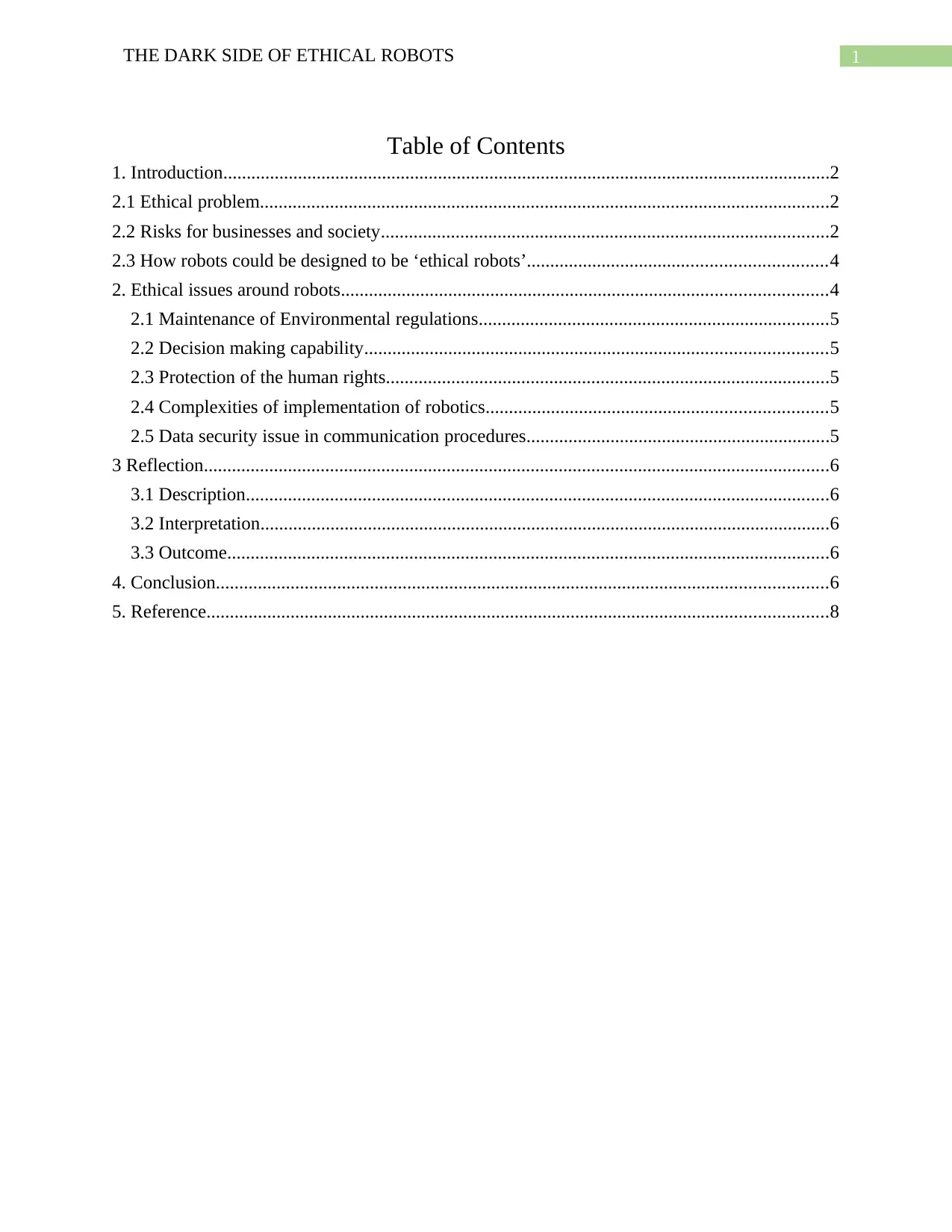
1THE DARK SIDE OF ETHICAL ROBOTS
Table of Contents
1. Introduction..................................................................................................................................2
2.1 Ethical problem..........................................................................................................................2
2.2 Risks for businesses and society................................................................................................2
2.3 How robots could be designed to be ‘ethical robots’................................................................4
2. Ethical issues around robots........................................................................................................4
2.1 Maintenance of Environmental regulations...........................................................................5
2.2 Decision making capability...................................................................................................5
2.3 Protection of the human rights...............................................................................................5
2.4 Complexities of implementation of robotics.........................................................................5
2.5 Data security issue in communication procedures.................................................................5
3 Reflection......................................................................................................................................6
3.1 Description.............................................................................................................................6
3.2 Interpretation..........................................................................................................................6
3.3 Outcome.................................................................................................................................6
4. Conclusion...................................................................................................................................6
5. Reference.....................................................................................................................................8
Table of Contents
1. Introduction..................................................................................................................................2
2.1 Ethical problem..........................................................................................................................2
2.2 Risks for businesses and society................................................................................................2
2.3 How robots could be designed to be ‘ethical robots’................................................................4
2. Ethical issues around robots........................................................................................................4
2.1 Maintenance of Environmental regulations...........................................................................5
2.2 Decision making capability...................................................................................................5
2.3 Protection of the human rights...............................................................................................5
2.4 Complexities of implementation of robotics.........................................................................5
2.5 Data security issue in communication procedures.................................................................5
3 Reflection......................................................................................................................................6
3.1 Description.............................................................................................................................6
3.2 Interpretation..........................................................................................................................6
3.3 Outcome.................................................................................................................................6
4. Conclusion...................................................................................................................................6
5. Reference.....................................................................................................................................8
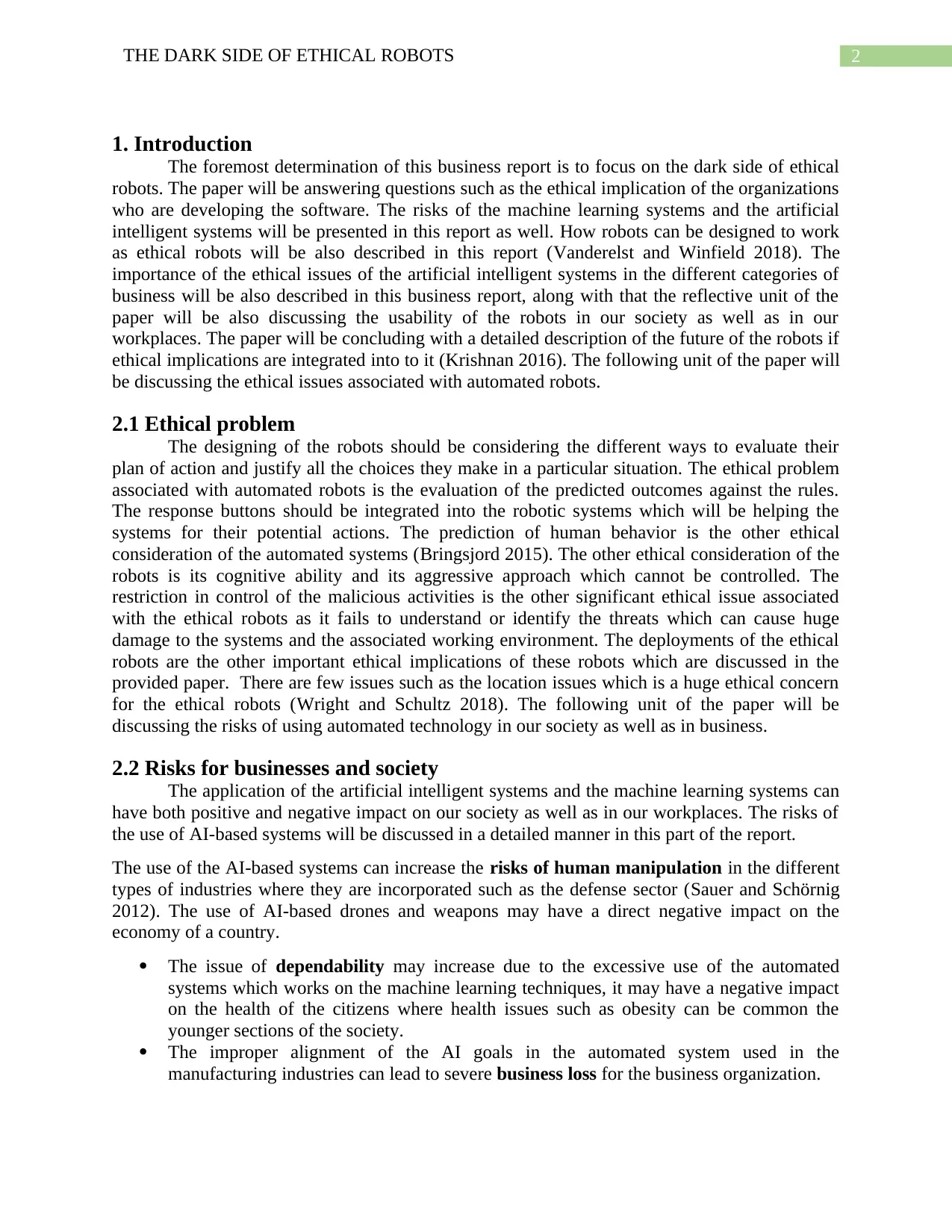
2THE DARK SIDE OF ETHICAL ROBOTS
1. Introduction
The foremost determination of this business report is to focus on the dark side of ethical
robots. The paper will be answering questions such as the ethical implication of the organizations
who are developing the software. The risks of the machine learning systems and the artificial
intelligent systems will be presented in this report as well. How robots can be designed to work
as ethical robots will be also described in this report (Vanderelst and Winfield 2018). The
importance of the ethical issues of the artificial intelligent systems in the different categories of
business will be also described in this business report, along with that the reflective unit of the
paper will be also discussing the usability of the robots in our society as well as in our
workplaces. The paper will be concluding with a detailed description of the future of the robots if
ethical implications are integrated into to it (Krishnan 2016). The following unit of the paper will
be discussing the ethical issues associated with automated robots.
2.1 Ethical problem
The designing of the robots should be considering the different ways to evaluate their
plan of action and justify all the choices they make in a particular situation. The ethical problem
associated with automated robots is the evaluation of the predicted outcomes against the rules.
The response buttons should be integrated into the robotic systems which will be helping the
systems for their potential actions. The prediction of human behavior is the other ethical
consideration of the automated systems (Bringsjord 2015). The other ethical consideration of the
robots is its cognitive ability and its aggressive approach which cannot be controlled. The
restriction in control of the malicious activities is the other significant ethical issue associated
with the ethical robots as it fails to understand or identify the threats which can cause huge
damage to the systems and the associated working environment. The deployments of the ethical
robots are the other important ethical implications of these robots which are discussed in the
provided paper. There are few issues such as the location issues which is a huge ethical concern
for the ethical robots (Wright and Schultz 2018). The following unit of the paper will be
discussing the risks of using automated technology in our society as well as in business.
2.2 Risks for businesses and society
The application of the artificial intelligent systems and the machine learning systems can
have both positive and negative impact on our society as well as in our workplaces. The risks of
the use of AI-based systems will be discussed in a detailed manner in this part of the report.
The use of the AI-based systems can increase the risks of human manipulation in the different
types of industries where they are incorporated such as the defense sector (Sauer and Schörnig
2012). The use of AI-based drones and weapons may have a direct negative impact on the
economy of a country.
The issue of dependability may increase due to the excessive use of the automated
systems which works on the machine learning techniques, it may have a negative impact
on the health of the citizens where health issues such as obesity can be common the
younger sections of the society.
The improper alignment of the AI goals in the automated system used in the
manufacturing industries can lead to severe business loss for the business organization.
1. Introduction
The foremost determination of this business report is to focus on the dark side of ethical
robots. The paper will be answering questions such as the ethical implication of the organizations
who are developing the software. The risks of the machine learning systems and the artificial
intelligent systems will be presented in this report as well. How robots can be designed to work
as ethical robots will be also described in this report (Vanderelst and Winfield 2018). The
importance of the ethical issues of the artificial intelligent systems in the different categories of
business will be also described in this business report, along with that the reflective unit of the
paper will be also discussing the usability of the robots in our society as well as in our
workplaces. The paper will be concluding with a detailed description of the future of the robots if
ethical implications are integrated into to it (Krishnan 2016). The following unit of the paper will
be discussing the ethical issues associated with automated robots.
2.1 Ethical problem
The designing of the robots should be considering the different ways to evaluate their
plan of action and justify all the choices they make in a particular situation. The ethical problem
associated with automated robots is the evaluation of the predicted outcomes against the rules.
The response buttons should be integrated into the robotic systems which will be helping the
systems for their potential actions. The prediction of human behavior is the other ethical
consideration of the automated systems (Bringsjord 2015). The other ethical consideration of the
robots is its cognitive ability and its aggressive approach which cannot be controlled. The
restriction in control of the malicious activities is the other significant ethical issue associated
with the ethical robots as it fails to understand or identify the threats which can cause huge
damage to the systems and the associated working environment. The deployments of the ethical
robots are the other important ethical implications of these robots which are discussed in the
provided paper. There are few issues such as the location issues which is a huge ethical concern
for the ethical robots (Wright and Schultz 2018). The following unit of the paper will be
discussing the risks of using automated technology in our society as well as in business.
2.2 Risks for businesses and society
The application of the artificial intelligent systems and the machine learning systems can
have both positive and negative impact on our society as well as in our workplaces. The risks of
the use of AI-based systems will be discussed in a detailed manner in this part of the report.
The use of the AI-based systems can increase the risks of human manipulation in the different
types of industries where they are incorporated such as the defense sector (Sauer and Schörnig
2012). The use of AI-based drones and weapons may have a direct negative impact on the
economy of a country.
The issue of dependability may increase due to the excessive use of the automated
systems which works on the machine learning techniques, it may have a negative impact
on the health of the citizens where health issues such as obesity can be common the
younger sections of the society.
The improper alignment of the AI goals in the automated system used in the
manufacturing industries can lead to severe business loss for the business organization.
⊘ This is a preview!⊘
Do you want full access?
Subscribe today to unlock all pages.

Trusted by 1+ million students worldwide
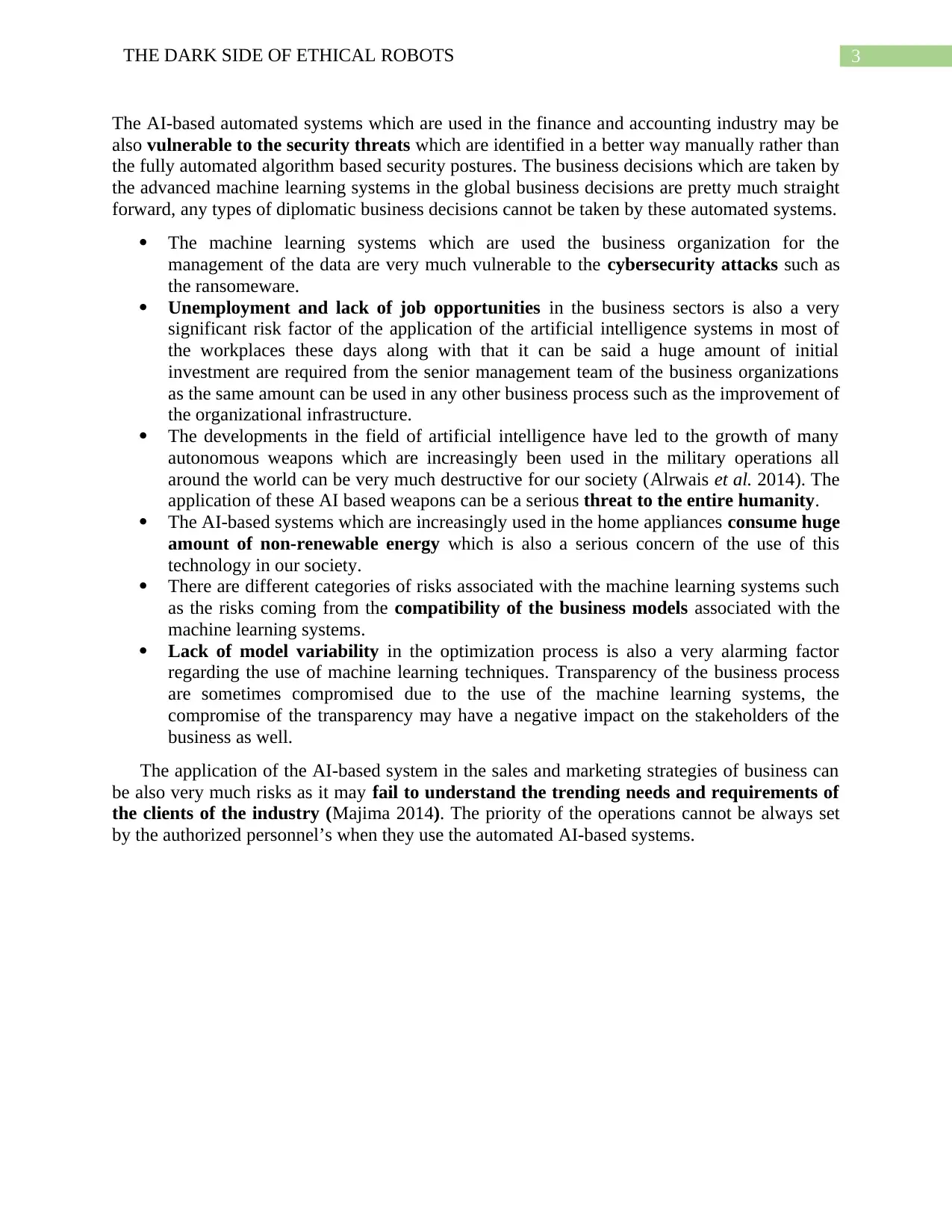
3THE DARK SIDE OF ETHICAL ROBOTS
The AI-based automated systems which are used in the finance and accounting industry may be
also vulnerable to the security threats which are identified in a better way manually rather than
the fully automated algorithm based security postures. The business decisions which are taken by
the advanced machine learning systems in the global business decisions are pretty much straight
forward, any types of diplomatic business decisions cannot be taken by these automated systems.
The machine learning systems which are used the business organization for the
management of the data are very much vulnerable to the cybersecurity attacks such as
the ransomeware.
Unemployment and lack of job opportunities in the business sectors is also a very
significant risk factor of the application of the artificial intelligence systems in most of
the workplaces these days along with that it can be said a huge amount of initial
investment are required from the senior management team of the business organizations
as the same amount can be used in any other business process such as the improvement of
the organizational infrastructure.
The developments in the field of artificial intelligence have led to the growth of many
autonomous weapons which are increasingly been used in the military operations all
around the world can be very much destructive for our society (Alrwais et al. 2014). The
application of these AI based weapons can be a serious threat to the entire humanity.
The AI-based systems which are increasingly used in the home appliances consume huge
amount of non-renewable energy which is also a serious concern of the use of this
technology in our society.
There are different categories of risks associated with the machine learning systems such
as the risks coming from the compatibility of the business models associated with the
machine learning systems.
Lack of model variability in the optimization process is also a very alarming factor
regarding the use of machine learning techniques. Transparency of the business process
are sometimes compromised due to the use of the machine learning systems, the
compromise of the transparency may have a negative impact on the stakeholders of the
business as well.
The application of the AI-based system in the sales and marketing strategies of business can
be also very much risks as it may fail to understand the trending needs and requirements of
the clients of the industry (Majima 2014). The priority of the operations cannot be always set
by the authorized personnel’s when they use the automated AI-based systems.
The AI-based automated systems which are used in the finance and accounting industry may be
also vulnerable to the security threats which are identified in a better way manually rather than
the fully automated algorithm based security postures. The business decisions which are taken by
the advanced machine learning systems in the global business decisions are pretty much straight
forward, any types of diplomatic business decisions cannot be taken by these automated systems.
The machine learning systems which are used the business organization for the
management of the data are very much vulnerable to the cybersecurity attacks such as
the ransomeware.
Unemployment and lack of job opportunities in the business sectors is also a very
significant risk factor of the application of the artificial intelligence systems in most of
the workplaces these days along with that it can be said a huge amount of initial
investment are required from the senior management team of the business organizations
as the same amount can be used in any other business process such as the improvement of
the organizational infrastructure.
The developments in the field of artificial intelligence have led to the growth of many
autonomous weapons which are increasingly been used in the military operations all
around the world can be very much destructive for our society (Alrwais et al. 2014). The
application of these AI based weapons can be a serious threat to the entire humanity.
The AI-based systems which are increasingly used in the home appliances consume huge
amount of non-renewable energy which is also a serious concern of the use of this
technology in our society.
There are different categories of risks associated with the machine learning systems such
as the risks coming from the compatibility of the business models associated with the
machine learning systems.
Lack of model variability in the optimization process is also a very alarming factor
regarding the use of machine learning techniques. Transparency of the business process
are sometimes compromised due to the use of the machine learning systems, the
compromise of the transparency may have a negative impact on the stakeholders of the
business as well.
The application of the AI-based system in the sales and marketing strategies of business can
be also very much risks as it may fail to understand the trending needs and requirements of
the clients of the industry (Majima 2014). The priority of the operations cannot be always set
by the authorized personnel’s when they use the automated AI-based systems.
Paraphrase This Document
Need a fresh take? Get an instant paraphrase of this document with our AI Paraphraser
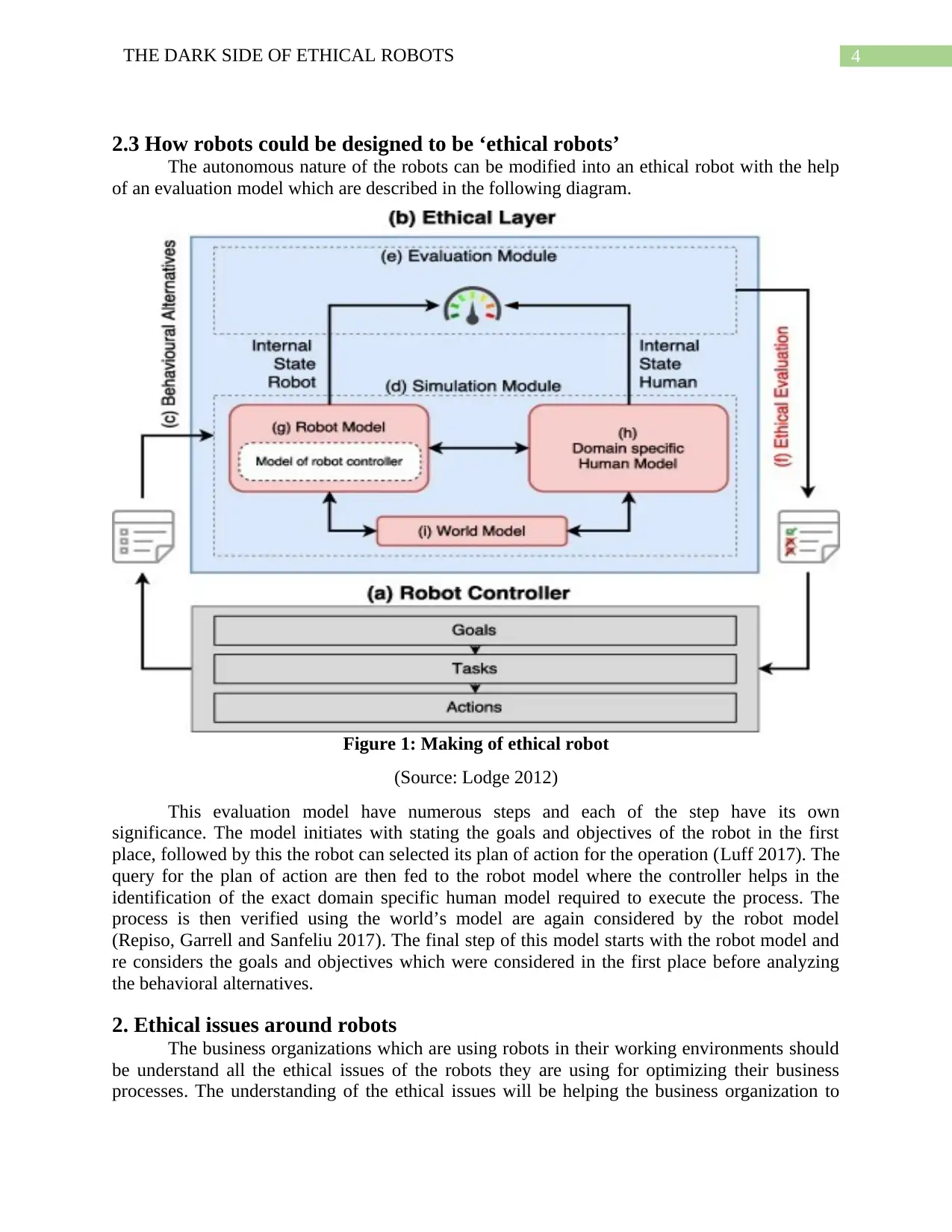
4THE DARK SIDE OF ETHICAL ROBOTS
2.3 How robots could be designed to be ‘ethical robots’
The autonomous nature of the robots can be modified into an ethical robot with the help
of an evaluation model which are described in the following diagram.
Figure 1: Making of ethical robot
(Source: Lodge 2012)
This evaluation model have numerous steps and each of the step have its own
significance. The model initiates with stating the goals and objectives of the robot in the first
place, followed by this the robot can selected its plan of action for the operation (Luff 2017). The
query for the plan of action are then fed to the robot model where the controller helps in the
identification of the exact domain specific human model required to execute the process. The
process is then verified using the world’s model are again considered by the robot model
(Repiso, Garrell and Sanfeliu 2017). The final step of this model starts with the robot model and
re considers the goals and objectives which were considered in the first place before analyzing
the behavioral alternatives.
2. Ethical issues around robots
The business organizations which are using robots in their working environments should
be understand all the ethical issues of the robots they are using for optimizing their business
processes. The understanding of the ethical issues will be helping the business organization to
2.3 How robots could be designed to be ‘ethical robots’
The autonomous nature of the robots can be modified into an ethical robot with the help
of an evaluation model which are described in the following diagram.
Figure 1: Making of ethical robot
(Source: Lodge 2012)
This evaluation model have numerous steps and each of the step have its own
significance. The model initiates with stating the goals and objectives of the robot in the first
place, followed by this the robot can selected its plan of action for the operation (Luff 2017). The
query for the plan of action are then fed to the robot model where the controller helps in the
identification of the exact domain specific human model required to execute the process. The
process is then verified using the world’s model are again considered by the robot model
(Repiso, Garrell and Sanfeliu 2017). The final step of this model starts with the robot model and
re considers the goals and objectives which were considered in the first place before analyzing
the behavioral alternatives.
2. Ethical issues around robots
The business organizations which are using robots in their working environments should
be understand all the ethical issues of the robots they are using for optimizing their business
processes. The understanding of the ethical issues will be helping the business organization to
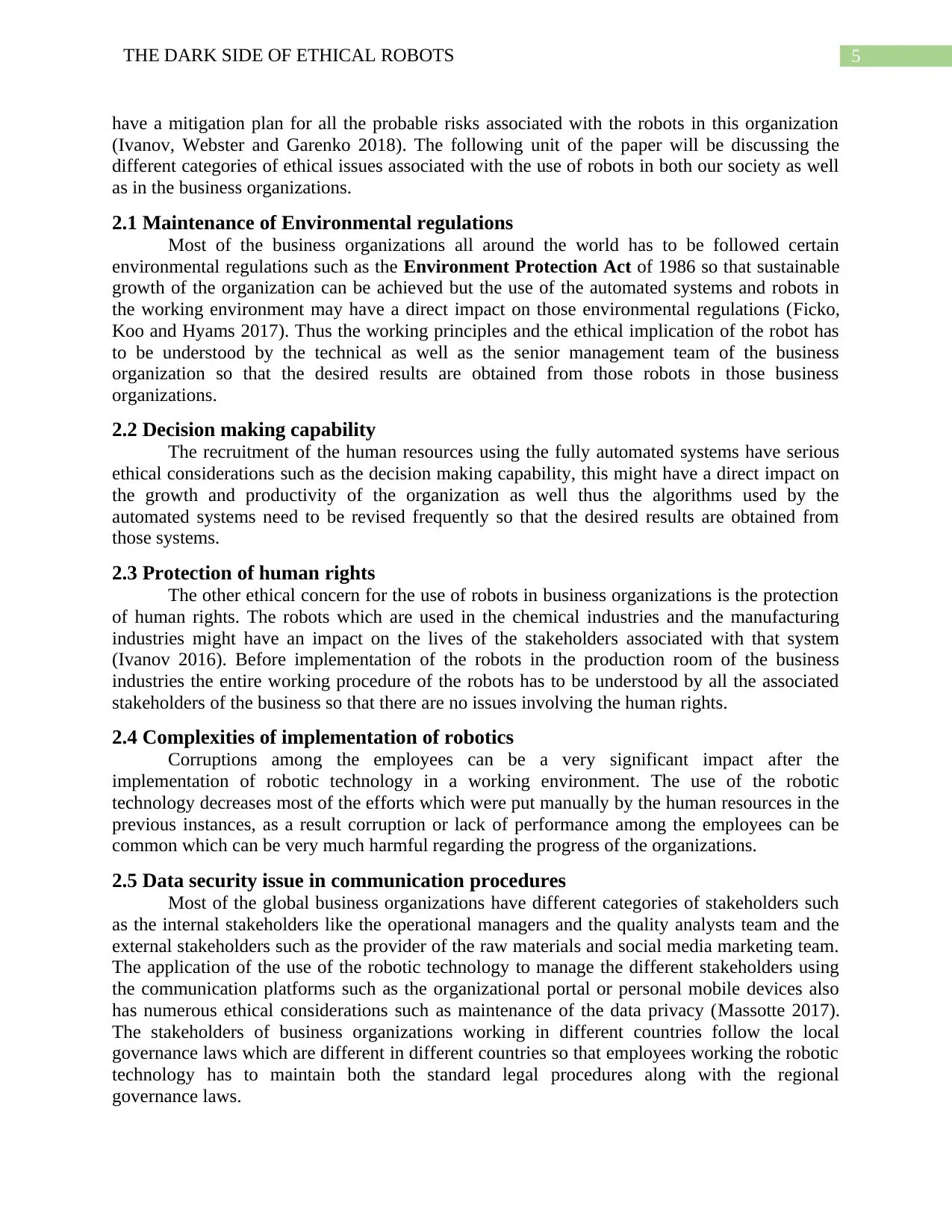
5THE DARK SIDE OF ETHICAL ROBOTS
have a mitigation plan for all the probable risks associated with the robots in this organization
(Ivanov, Webster and Garenko 2018). The following unit of the paper will be discussing the
different categories of ethical issues associated with the use of robots in both our society as well
as in the business organizations.
2.1 Maintenance of Environmental regulations
Most of the business organizations all around the world has to be followed certain
environmental regulations such as the Environment Protection Act of 1986 so that sustainable
growth of the organization can be achieved but the use of the automated systems and robots in
the working environment may have a direct impact on those environmental regulations (Ficko,
Koo and Hyams 2017). Thus the working principles and the ethical implication of the robot has
to be understood by the technical as well as the senior management team of the business
organization so that the desired results are obtained from those robots in those business
organizations.
2.2 Decision making capability
The recruitment of the human resources using the fully automated systems have serious
ethical considerations such as the decision making capability, this might have a direct impact on
the growth and productivity of the organization as well thus the algorithms used by the
automated systems need to be revised frequently so that the desired results are obtained from
those systems.
2.3 Protection of human rights
The other ethical concern for the use of robots in business organizations is the protection
of human rights. The robots which are used in the chemical industries and the manufacturing
industries might have an impact on the lives of the stakeholders associated with that system
(Ivanov 2016). Before implementation of the robots in the production room of the business
industries the entire working procedure of the robots has to be understood by all the associated
stakeholders of the business so that there are no issues involving the human rights.
2.4 Complexities of implementation of robotics
Corruptions among the employees can be a very significant impact after the
implementation of robotic technology in a working environment. The use of the robotic
technology decreases most of the efforts which were put manually by the human resources in the
previous instances, as a result corruption or lack of performance among the employees can be
common which can be very much harmful regarding the progress of the organizations.
2.5 Data security issue in communication procedures
Most of the global business organizations have different categories of stakeholders such
as the internal stakeholders like the operational managers and the quality analysts team and the
external stakeholders such as the provider of the raw materials and social media marketing team.
The application of the use of the robotic technology to manage the different stakeholders using
the communication platforms such as the organizational portal or personal mobile devices also
has numerous ethical considerations such as maintenance of the data privacy (Massotte 2017).
The stakeholders of business organizations working in different countries follow the local
governance laws which are different in different countries so that employees working the robotic
technology has to maintain both the standard legal procedures along with the regional
governance laws.
have a mitigation plan for all the probable risks associated with the robots in this organization
(Ivanov, Webster and Garenko 2018). The following unit of the paper will be discussing the
different categories of ethical issues associated with the use of robots in both our society as well
as in the business organizations.
2.1 Maintenance of Environmental regulations
Most of the business organizations all around the world has to be followed certain
environmental regulations such as the Environment Protection Act of 1986 so that sustainable
growth of the organization can be achieved but the use of the automated systems and robots in
the working environment may have a direct impact on those environmental regulations (Ficko,
Koo and Hyams 2017). Thus the working principles and the ethical implication of the robot has
to be understood by the technical as well as the senior management team of the business
organization so that the desired results are obtained from those robots in those business
organizations.
2.2 Decision making capability
The recruitment of the human resources using the fully automated systems have serious
ethical considerations such as the decision making capability, this might have a direct impact on
the growth and productivity of the organization as well thus the algorithms used by the
automated systems need to be revised frequently so that the desired results are obtained from
those systems.
2.3 Protection of human rights
The other ethical concern for the use of robots in business organizations is the protection
of human rights. The robots which are used in the chemical industries and the manufacturing
industries might have an impact on the lives of the stakeholders associated with that system
(Ivanov 2016). Before implementation of the robots in the production room of the business
industries the entire working procedure of the robots has to be understood by all the associated
stakeholders of the business so that there are no issues involving the human rights.
2.4 Complexities of implementation of robotics
Corruptions among the employees can be a very significant impact after the
implementation of robotic technology in a working environment. The use of the robotic
technology decreases most of the efforts which were put manually by the human resources in the
previous instances, as a result corruption or lack of performance among the employees can be
common which can be very much harmful regarding the progress of the organizations.
2.5 Data security issue in communication procedures
Most of the global business organizations have different categories of stakeholders such
as the internal stakeholders like the operational managers and the quality analysts team and the
external stakeholders such as the provider of the raw materials and social media marketing team.
The application of the use of the robotic technology to manage the different stakeholders using
the communication platforms such as the organizational portal or personal mobile devices also
has numerous ethical considerations such as maintenance of the data privacy (Massotte 2017).
The stakeholders of business organizations working in different countries follow the local
governance laws which are different in different countries so that employees working the robotic
technology has to maintain both the standard legal procedures along with the regional
governance laws.
⊘ This is a preview!⊘
Do you want full access?
Subscribe today to unlock all pages.

Trusted by 1+ million students worldwide
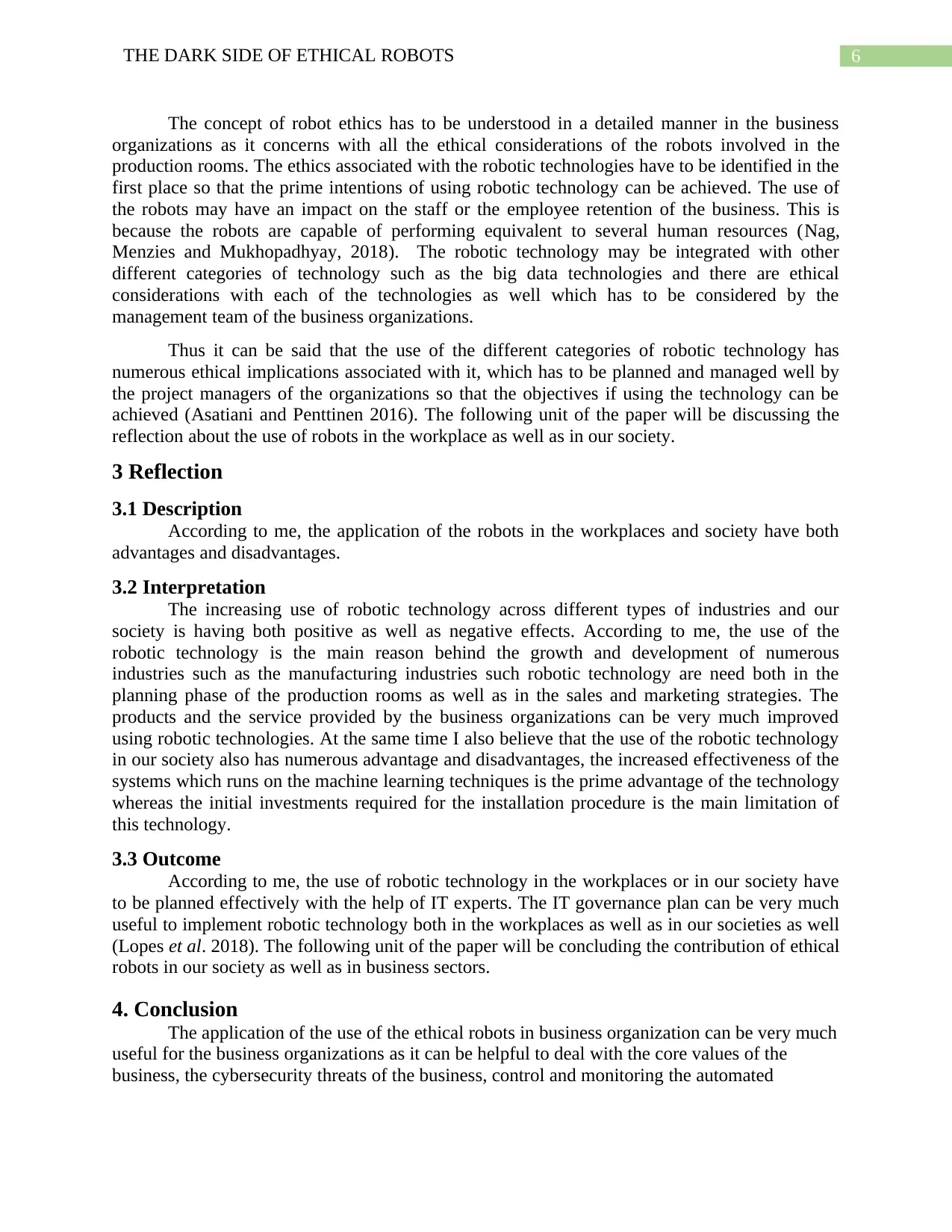
6THE DARK SIDE OF ETHICAL ROBOTS
The concept of robot ethics has to be understood in a detailed manner in the business
organizations as it concerns with all the ethical considerations of the robots involved in the
production rooms. The ethics associated with the robotic technologies have to be identified in the
first place so that the prime intentions of using robotic technology can be achieved. The use of
the robots may have an impact on the staff or the employee retention of the business. This is
because the robots are capable of performing equivalent to several human resources (Nag,
Menzies and Mukhopadhyay, 2018). The robotic technology may be integrated with other
different categories of technology such as the big data technologies and there are ethical
considerations with each of the technologies as well which has to be considered by the
management team of the business organizations.
Thus it can be said that the use of the different categories of robotic technology has
numerous ethical implications associated with it, which has to be planned and managed well by
the project managers of the organizations so that the objectives if using the technology can be
achieved (Asatiani and Penttinen 2016). The following unit of the paper will be discussing the
reflection about the use of robots in the workplace as well as in our society.
3 Reflection
3.1 Description
According to me, the application of the robots in the workplaces and society have both
advantages and disadvantages.
3.2 Interpretation
The increasing use of robotic technology across different types of industries and our
society is having both positive as well as negative effects. According to me, the use of the
robotic technology is the main reason behind the growth and development of numerous
industries such as the manufacturing industries such robotic technology are need both in the
planning phase of the production rooms as well as in the sales and marketing strategies. The
products and the service provided by the business organizations can be very much improved
using robotic technologies. At the same time I also believe that the use of the robotic technology
in our society also has numerous advantage and disadvantages, the increased effectiveness of the
systems which runs on the machine learning techniques is the prime advantage of the technology
whereas the initial investments required for the installation procedure is the main limitation of
this technology.
3.3 Outcome
According to me, the use of robotic technology in the workplaces or in our society have
to be planned effectively with the help of IT experts. The IT governance plan can be very much
useful to implement robotic technology both in the workplaces as well as in our societies as well
(Lopes et al. 2018). The following unit of the paper will be concluding the contribution of ethical
robots in our society as well as in business sectors.
4. Conclusion
The application of the use of the ethical robots in business organization can be very much
useful for the business organizations as it can be helpful to deal with the core values of the
business, the cybersecurity threats of the business, control and monitoring the automated
The concept of robot ethics has to be understood in a detailed manner in the business
organizations as it concerns with all the ethical considerations of the robots involved in the
production rooms. The ethics associated with the robotic technologies have to be identified in the
first place so that the prime intentions of using robotic technology can be achieved. The use of
the robots may have an impact on the staff or the employee retention of the business. This is
because the robots are capable of performing equivalent to several human resources (Nag,
Menzies and Mukhopadhyay, 2018). The robotic technology may be integrated with other
different categories of technology such as the big data technologies and there are ethical
considerations with each of the technologies as well which has to be considered by the
management team of the business organizations.
Thus it can be said that the use of the different categories of robotic technology has
numerous ethical implications associated with it, which has to be planned and managed well by
the project managers of the organizations so that the objectives if using the technology can be
achieved (Asatiani and Penttinen 2016). The following unit of the paper will be discussing the
reflection about the use of robots in the workplace as well as in our society.
3 Reflection
3.1 Description
According to me, the application of the robots in the workplaces and society have both
advantages and disadvantages.
3.2 Interpretation
The increasing use of robotic technology across different types of industries and our
society is having both positive as well as negative effects. According to me, the use of the
robotic technology is the main reason behind the growth and development of numerous
industries such as the manufacturing industries such robotic technology are need both in the
planning phase of the production rooms as well as in the sales and marketing strategies. The
products and the service provided by the business organizations can be very much improved
using robotic technologies. At the same time I also believe that the use of the robotic technology
in our society also has numerous advantage and disadvantages, the increased effectiveness of the
systems which runs on the machine learning techniques is the prime advantage of the technology
whereas the initial investments required for the installation procedure is the main limitation of
this technology.
3.3 Outcome
According to me, the use of robotic technology in the workplaces or in our society have
to be planned effectively with the help of IT experts. The IT governance plan can be very much
useful to implement robotic technology both in the workplaces as well as in our societies as well
(Lopes et al. 2018). The following unit of the paper will be concluding the contribution of ethical
robots in our society as well as in business sectors.
4. Conclusion
The application of the use of the ethical robots in business organization can be very much
useful for the business organizations as it can be helpful to deal with the core values of the
business, the cybersecurity threats of the business, control and monitoring the automated
Paraphrase This Document
Need a fresh take? Get an instant paraphrase of this document with our AI Paraphraser
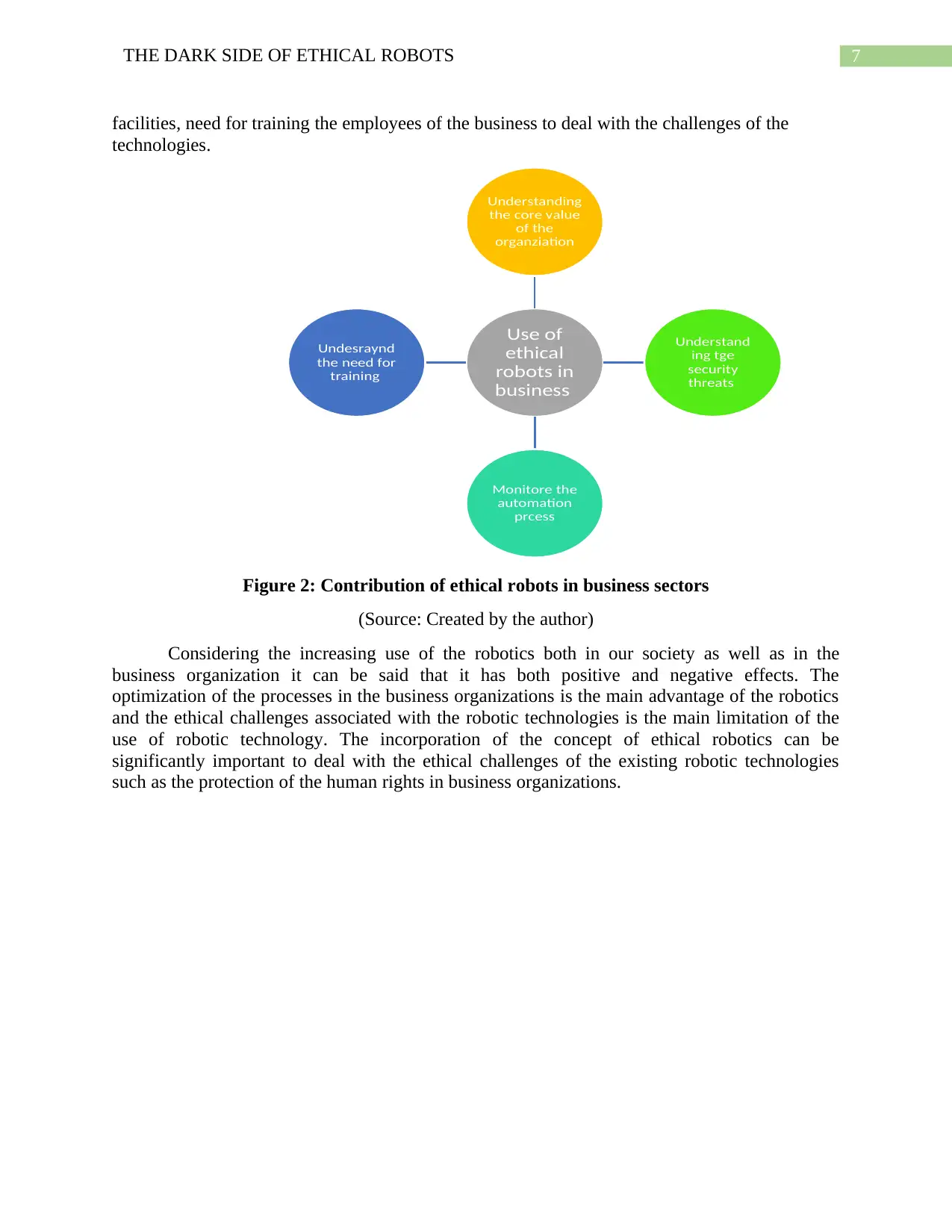
7THE DARK SIDE OF ETHICAL ROBOTS
facilities, need for training the employees of the business to deal with the challenges of the
technologies.
Figure 2: Contribution of ethical robots in business sectors
(Source: Created by the author)
Considering the increasing use of the robotics both in our society as well as in the
business organization it can be said that it has both positive and negative effects. The
optimization of the processes in the business organizations is the main advantage of the robotics
and the ethical challenges associated with the robotic technologies is the main limitation of the
use of robotic technology. The incorporation of the concept of ethical robotics can be
significantly important to deal with the ethical challenges of the existing robotic technologies
such as the protection of the human rights in business organizations.
Use of
ethical
robots in
business
Understanding
the core value
of the
organziation
Understand
ing tge
security
threats
Monitore the
automation
prcess
Undesraynd
the need for
training
facilities, need for training the employees of the business to deal with the challenges of the
technologies.
Figure 2: Contribution of ethical robots in business sectors
(Source: Created by the author)
Considering the increasing use of the robotics both in our society as well as in the
business organization it can be said that it has both positive and negative effects. The
optimization of the processes in the business organizations is the main advantage of the robotics
and the ethical challenges associated with the robotic technologies is the main limitation of the
use of robotic technology. The incorporation of the concept of ethical robotics can be
significantly important to deal with the ethical challenges of the existing robotic technologies
such as the protection of the human rights in business organizations.
Use of
ethical
robots in
business
Understanding
the core value
of the
organziation
Understand
ing tge
security
threats
Monitore the
automation
prcess
Undesraynd
the need for
training
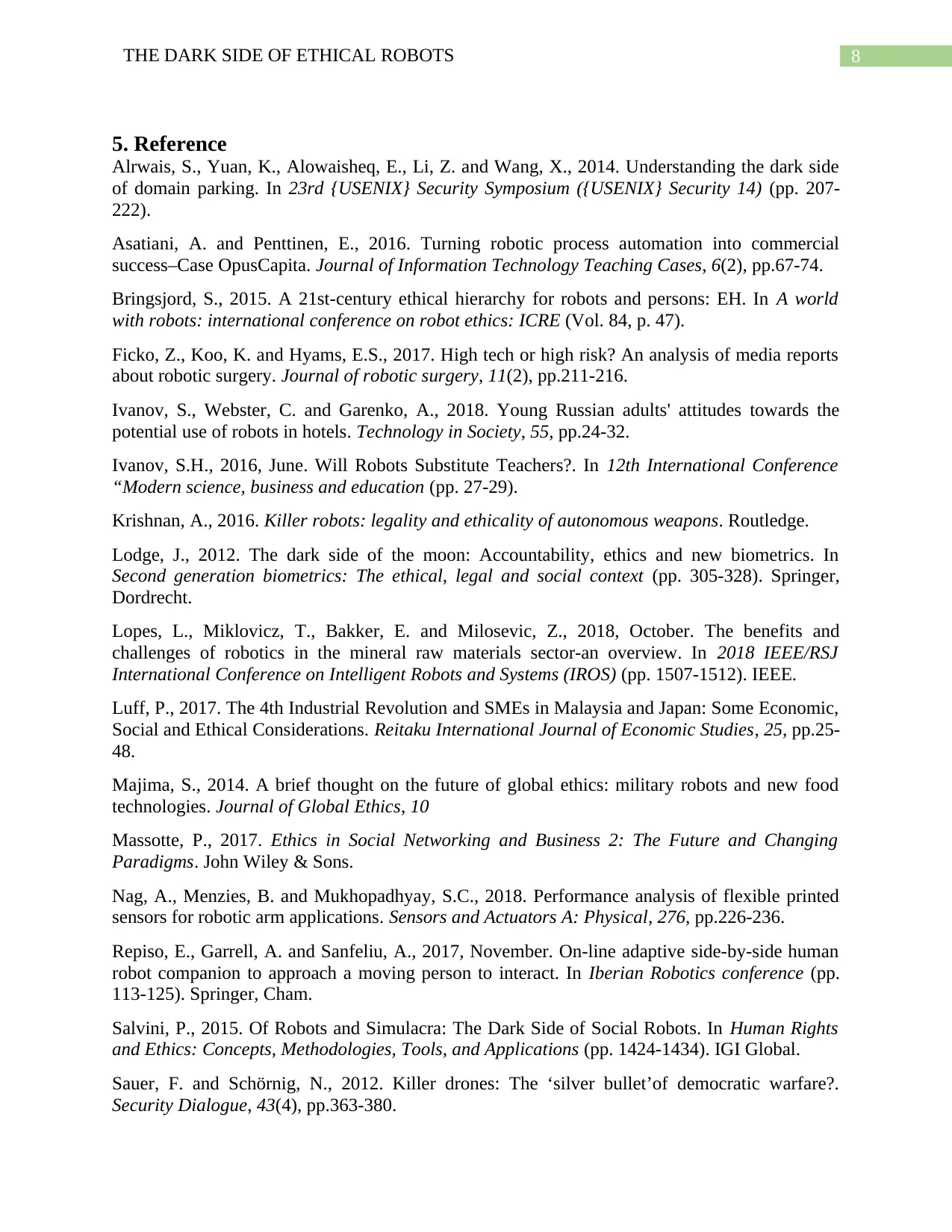
8THE DARK SIDE OF ETHICAL ROBOTS
5. Reference
Alrwais, S., Yuan, K., Alowaisheq, E., Li, Z. and Wang, X., 2014. Understanding the dark side
of domain parking. In 23rd {USENIX} Security Symposium ({USENIX} Security 14) (pp. 207-
222).
Asatiani, A. and Penttinen, E., 2016. Turning robotic process automation into commercial
success–Case OpusCapita. Journal of Information Technology Teaching Cases, 6(2), pp.67-74.
Bringsjord, S., 2015. A 21st-century ethical hierarchy for robots and persons: EH. In A world
with robots: international conference on robot ethics: ICRE (Vol. 84, p. 47).
Ficko, Z., Koo, K. and Hyams, E.S., 2017. High tech or high risk? An analysis of media reports
about robotic surgery. Journal of robotic surgery, 11(2), pp.211-216.
Ivanov, S., Webster, C. and Garenko, A., 2018. Young Russian adults' attitudes towards the
potential use of robots in hotels. Technology in Society, 55, pp.24-32.
Ivanov, S.H., 2016, June. Will Robots Substitute Teachers?. In 12th International Conference
“Modern science, business and education (pp. 27-29).
Krishnan, A., 2016. Killer robots: legality and ethicality of autonomous weapons. Routledge.
Lodge, J., 2012. The dark side of the moon: Accountability, ethics and new biometrics. In
Second generation biometrics: The ethical, legal and social context (pp. 305-328). Springer,
Dordrecht.
Lopes, L., Miklovicz, T., Bakker, E. and Milosevic, Z., 2018, October. The benefits and
challenges of robotics in the mineral raw materials sector-an overview. In 2018 IEEE/RSJ
International Conference on Intelligent Robots and Systems (IROS) (pp. 1507-1512). IEEE.
Luff, P., 2017. The 4th Industrial Revolution and SMEs in Malaysia and Japan: Some Economic,
Social and Ethical Considerations. Reitaku International Journal of Economic Studies, 25, pp.25-
48.
Majima, S., 2014. A brief thought on the future of global ethics: military robots and new food
technologies. Journal of Global Ethics, 10
Massotte, P., 2017. Ethics in Social Networking and Business 2: The Future and Changing
Paradigms. John Wiley & Sons.
Nag, A., Menzies, B. and Mukhopadhyay, S.C., 2018. Performance analysis of flexible printed
sensors for robotic arm applications. Sensors and Actuators A: Physical, 276, pp.226-236.
Repiso, E., Garrell, A. and Sanfeliu, A., 2017, November. On-line adaptive side-by-side human
robot companion to approach a moving person to interact. In Iberian Robotics conference (pp.
113-125). Springer, Cham.
Salvini, P., 2015. Of Robots and Simulacra: The Dark Side of Social Robots. In Human Rights
and Ethics: Concepts, Methodologies, Tools, and Applications (pp. 1424-1434). IGI Global.
Sauer, F. and Schörnig, N., 2012. Killer drones: The ‘silver bullet’of democratic warfare?.
Security Dialogue, 43(4), pp.363-380.
5. Reference
Alrwais, S., Yuan, K., Alowaisheq, E., Li, Z. and Wang, X., 2014. Understanding the dark side
of domain parking. In 23rd {USENIX} Security Symposium ({USENIX} Security 14) (pp. 207-
222).
Asatiani, A. and Penttinen, E., 2016. Turning robotic process automation into commercial
success–Case OpusCapita. Journal of Information Technology Teaching Cases, 6(2), pp.67-74.
Bringsjord, S., 2015. A 21st-century ethical hierarchy for robots and persons: EH. In A world
with robots: international conference on robot ethics: ICRE (Vol. 84, p. 47).
Ficko, Z., Koo, K. and Hyams, E.S., 2017. High tech or high risk? An analysis of media reports
about robotic surgery. Journal of robotic surgery, 11(2), pp.211-216.
Ivanov, S., Webster, C. and Garenko, A., 2018. Young Russian adults' attitudes towards the
potential use of robots in hotels. Technology in Society, 55, pp.24-32.
Ivanov, S.H., 2016, June. Will Robots Substitute Teachers?. In 12th International Conference
“Modern science, business and education (pp. 27-29).
Krishnan, A., 2016. Killer robots: legality and ethicality of autonomous weapons. Routledge.
Lodge, J., 2012. The dark side of the moon: Accountability, ethics and new biometrics. In
Second generation biometrics: The ethical, legal and social context (pp. 305-328). Springer,
Dordrecht.
Lopes, L., Miklovicz, T., Bakker, E. and Milosevic, Z., 2018, October. The benefits and
challenges of robotics in the mineral raw materials sector-an overview. In 2018 IEEE/RSJ
International Conference on Intelligent Robots and Systems (IROS) (pp. 1507-1512). IEEE.
Luff, P., 2017. The 4th Industrial Revolution and SMEs in Malaysia and Japan: Some Economic,
Social and Ethical Considerations. Reitaku International Journal of Economic Studies, 25, pp.25-
48.
Majima, S., 2014. A brief thought on the future of global ethics: military robots and new food
technologies. Journal of Global Ethics, 10
Massotte, P., 2017. Ethics in Social Networking and Business 2: The Future and Changing
Paradigms. John Wiley & Sons.
Nag, A., Menzies, B. and Mukhopadhyay, S.C., 2018. Performance analysis of flexible printed
sensors for robotic arm applications. Sensors and Actuators A: Physical, 276, pp.226-236.
Repiso, E., Garrell, A. and Sanfeliu, A., 2017, November. On-line adaptive side-by-side human
robot companion to approach a moving person to interact. In Iberian Robotics conference (pp.
113-125). Springer, Cham.
Salvini, P., 2015. Of Robots and Simulacra: The Dark Side of Social Robots. In Human Rights
and Ethics: Concepts, Methodologies, Tools, and Applications (pp. 1424-1434). IGI Global.
Sauer, F. and Schörnig, N., 2012. Killer drones: The ‘silver bullet’of democratic warfare?.
Security Dialogue, 43(4), pp.363-380.
⊘ This is a preview!⊘
Do you want full access?
Subscribe today to unlock all pages.

Trusted by 1+ million students worldwide

9THE DARK SIDE OF ETHICAL ROBOTS
Vanderelst, D. and Winfield, A., 2018, December. The dark side of ethical robots. In
Proceedings of the 2018 AAAI/ACM Conference on AI, Ethics, and Society (pp. 317-322). ACM.
Wright, S.A. and Schultz, A.E., 2018. The rising tide of artificial intelligence and business
automation: Developing an ethical framework. Business Horizons, 61(6), pp.823-832.
Vanderelst, D. and Winfield, A., 2018, December. The dark side of ethical robots. In
Proceedings of the 2018 AAAI/ACM Conference on AI, Ethics, and Society (pp. 317-322). ACM.
Wright, S.A. and Schultz, A.E., 2018. The rising tide of artificial intelligence and business
automation: Developing an ethical framework. Business Horizons, 61(6), pp.823-832.
1 out of 10
Related Documents
Your All-in-One AI-Powered Toolkit for Academic Success.
+13062052269
info@desklib.com
Available 24*7 on WhatsApp / Email
![[object Object]](/_next/static/media/star-bottom.7253800d.svg)
Unlock your academic potential
Copyright © 2020–2025 A2Z Services. All Rights Reserved. Developed and managed by ZUCOL.





